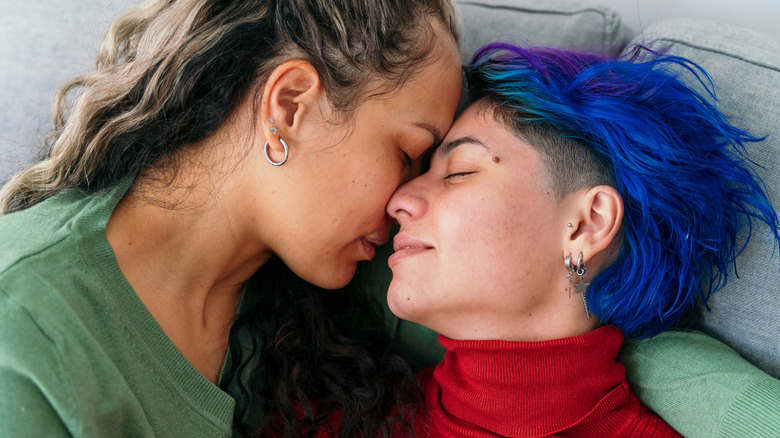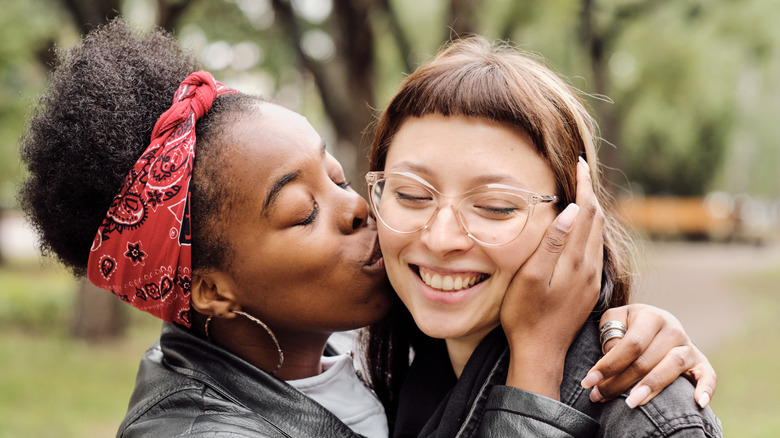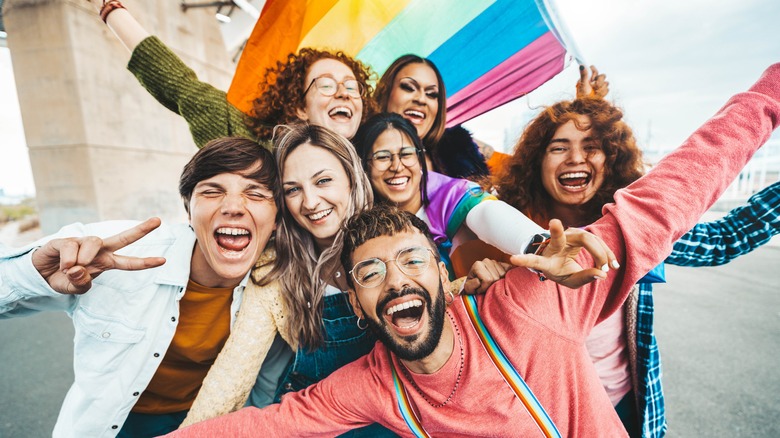What's The Difference Between Bisexual And Pansexual?
While society still has a long way to go with LGBTQ+ representation, it's safe to say the past two decades have been progress, particularly when it comes to helping people feel included. As of 2024, more people than ever are identifying as LGBTQ+, which indicates a growing number of people feel comfortable enough to be themselves. Better yet, there are so many different labels a person can adopt now (that go beyond the original acronym) to help them feel seen. One of those labels is pansexual. Thanks to the likes of celebrities like Janelle Monae and Wayne Brady, as well as characters like David Rose on "Schitt's Creek," the identity has finally entered mainstream conversations. But what does it really mean? And how is it different from being bi?
"'Pansexual,' is used to describe attraction (sexual and/or romantic) to someone of any gender," Dr. Kat Arenella, a Licensed Psychologist, Certified Sex Therapist and Clinical Associate at Modern Intimacy exclusively tells Women.com. Bisexual, on the other hand commonly refers to attraction to people of your same gender, as well as other genders.
Definitions around the two different LGBTQ+ orientations have evolved over time, so to ensure that we got it right, Women.com consulted Dr. Arenella for insight. "The reality is that these two labels have a lot of overlap, and that people use them in different and unique ways," they note. However, they are not the same thing. And there's a lot more nuance to unpack there, too.
Pansexuality falls under the bisexual umbrella
The word 'pansexual' itself stems from 'pansexualism,' a phrase used by psychiatrists in the mid 20th century that had nothing to do with one's orientation, but instead, the Freudian-like theory that sex impacts every one of our interactions. It wasn't until the 1970 and 1980s that people started using it to describe their preferences, and even then it's not completely clear how the current definition came to be. Them posits that it is a term that evolved out of political motivations to acknowledge the genderqueer community, who, at the time, may have found the word bisexual exclusionary.
Bisexuality has also had a long, and often shifting history within the queer lexicon. As early as the 19th century, anatomists used the phrase "bisexual" to refer to male and female characteristics in one person. A hundred years later, in the 1970s and '80s, the term shifted to mean attraction to both men and women. In its contemporary use, "bisexuality" refers to attraction to more than one gender, and not necessarily just "two."
Because of this expanded definition, many people may view pansexual as falling under the bisexual umbrella, since it implies potential attraction to multiple genders. However, the reasons why someone might use the pan label can be quite complex. "For some folks, [being pansexual] can truly mean [attraction to] 'all' genders, but for others, this term is more about the ability to feel attraction for someone regardless of their gender, or for a variety of genders," explains Dr. Arenella. Think David Rose's iconic line on Netflix show "Schitt"s Creek": "I like the wine, not the label."
Of course, it's important to keep in mind that just because a person identifies as pansexual does not mean they are sexually or romantically attracted to every human they meet. Nor does it mean they don't have preferences, like bisexual people. "This is a belief rooted in monosexism, or the discrimination against those who are attracted to more than one gender," points out Dr. Arenella. Rather, the main difference is that gender is less likely to be a factor in attraction, if at all. As one self-identifying pansexual TikToker put it, "[Pansexual] means for me, that I love people based on who they are, who their soul is, what their energy is. I don't fall in love with parts."
@needy_neuro_divergent Happy Pan Visibility Day!! #pansexualpride #pansexuals #lgbtqia #loveislove #heartsnotparts
How people delineate 'bisexual,' 'pansexual,' and 'queer' labels
The wonderful thing about multiple labels existing is it gives so many people with unique experiences the opportunity to feel seen and understood. "People pick the label that resonates most with them. For example, some choose to primarily label themselves as pansexual because it emphasizes attraction to any or all people," explains Dr. Arenella. Some people also find the pan description the simplest, and most inclusive way to represent their dating preferences to others. "Others may choose to identify with bisexuality because of the history with this term, including bisexual activism and ongoing erasure of this community." Often, many people in straight-passing relationships find using the term bisexual affirming of their queer identity.
"Some people feel that the term 'bisexual' connotes a binary view of gender, but this is not how most bisexual people define themselves, in reality," points out Dr. Arenella. In fact, the belief that bisexuality refers solely to liking cis-men and cis-women is one of the most common myths about bisexuality. "Bisexuality, in simple terms, really just means attraction to more than one gender, and indeed can recognize a gender spectrum," they said. "For example, for one person, bisexuality may mean attraction to any gender, while for another, this label may mean attraction to only cis women and nonbinary individuals."
"Someone's label may also have to do with other factors, such as common terminology in a specific region or community group." Dr. Arenella adds. They noted that some people may find their sexuality evolves and changes over time, so as they get older, they may find themselves identifying with different, or even multiple labels. In fact, some people describe themselves as both bi and pan, or queer which is totally valid! Moreover, the terms "bisexual" and "pansexual" may fit into the umbrella term "queer," but being queer can be a broader thing, too. As Dr. Arenella explained, the queer identity means renouncing heteronormative expectations, whether that refers to sexual orientation or gender identity. "Someone might prefer the label 'queer' because it centers liberation, their politics, and/or is a reclamation of a previously derogatory term," they said.


